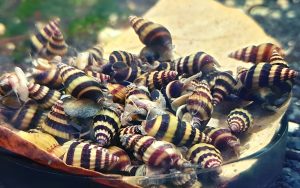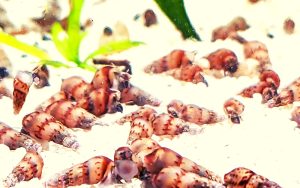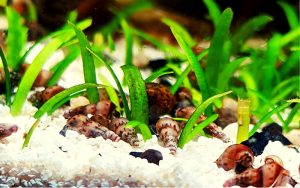Mastering Breeding Malaysian Trumpet Snails: Have you ever considered adding a unique and low-maintenance inhabitant to your freshwater aquarium? Look no further than the fascinating Malaysian Trumpet Snail! These little mollusks are not only efficient algae eaters but also surprisingly captivating to observe.
If you’ve ever been curious about breeding Trumpet Snails, this comprehensive beginner’s guide is your ticket to success. Get ready to unlock the secrets of these slow-moving marvels.
We’ll delve into everything from setting up the ideal Malaysian trumpet snails breeding environment and understanding their reproductive cycle to caring for adorable baby snails and ensuring a thriving snail population.
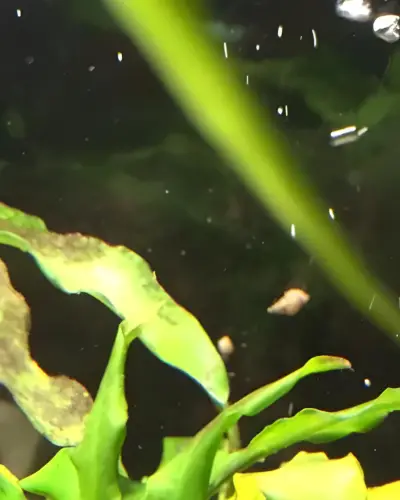
Whether you’re an experienced aquarist or just starting your underwater journey, breeding trumpet snails is easier than you might think!
Table of Contents
ToggleNatural Habitat of the Malaysian Trumpet Snails
Malaysian Trumpet Snails (Melanoides tuberculata) are freshwater snails belonging to the Thiaridae family. These snail species are hardy and can survive in a wide range of water parameters.
They are commonly used as part of a clean-up crew in aquariums, as they feed on organic matter and help keep the tank clean. Malaysian Trumpet Snails have a conical shape with a cone-like shell on their backs.
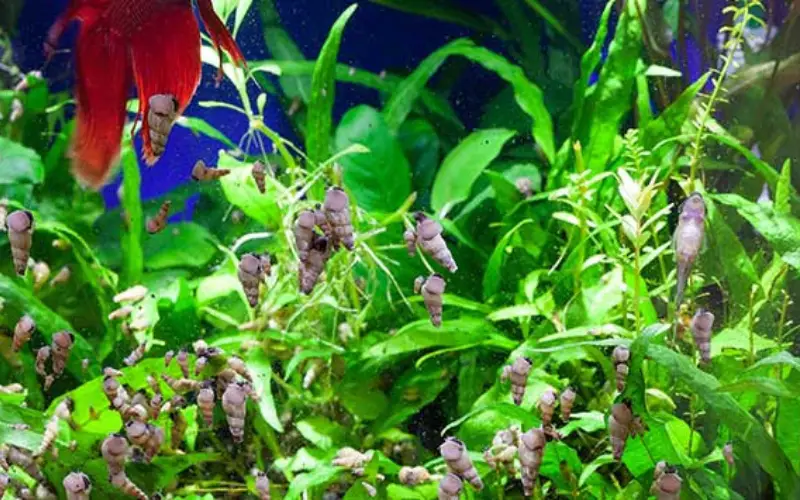
The shells are dark brown or beige with dark brown markings. The female Malaysian Trumpet Snails are slightly larger than the males, and they give birth to young snails instead of laying eggs.
These snails reproduce quickly, and their populations can grow rapidly if not kept under control. They are often considered pest snails because they can get out of control in a tank. However, they can be beneficial in controlled numbers as they help aerate the substrate and eat leftover food.
Malaysian Trumpet Snails prefer freshwater of higher altitudes, which can be found in both flowing and stagnant water. They can also survive in water ranging from weakly saline to freshwater with a pH of around 8.0 and a kh hardness.
Snail Power: Benefits of Snails for a Shrimp Aquarium
Adding snails to your shrimp aquarium can be a fantastic way to create a balanced and thriving ecosystem. These little mollusks offer several benefits, making them ideal tank mates for your shrimp:
Cleaning Crew Extraordinaire:
- Algae Eaters: Snails are champions at munching on algae, helping to keep your tank clean and free of unsightly green growth. This is especially beneficial for shrimp, as excessive algae can compete for resources and impact water quality.
- Detritus Removal: Snails also consume leftover food, decaying plant matter, and other organic debris, acting as natural vacuum cleaners for your aquarium.
Improved Substrate Health:
- Aerators: As snails burrow and move through the substrate, they help aerate it, preventing the build-up of harmful anaerobic bacteria and ensuring proper oxygenation for your shrimp’s delicate exoskeleton and overall health.
- Waste Breakdown: Snails contribute to the breakdown of waste products in the substrate, further promoting a healthy environment for your shrimp.
Additional Perks:
- Peaceful Cohabitation: Most snail species are quiet and pose no threat to shrimp, making them ideal tank mates.
- Interesting to Observe: Watching snails graze and interact within the aquarium adds a captivating dynamic to your shrimp tank.
- Variety of Species: With various snail species available, you can choose the perfect fit for your aquarium’s aesthetics and needs.
Remember: It’s important to research and select snail species that are compatible with shrimp and will keep your tank supplied. With careful consideration, snails can become valuable additions to your shrimp aquarium, contributing to a healthy and thriving environment for all its inhabitants.
Tips for Successful Breeding Malaysian Trumpet Snails
Malaysian trumpet snails breeding: Malaysian Trumpet Snails are aquatic snails that are commonly kept in fish or shrimp tanks. If you are looking to breed these snails successfully, there are a few tips to keep in mind.
Firstly, ensure that the water hardness and pH levels are appropriate for the snails, as they prefer tropical freshwater conditions. Malaysian Trumpet Snails are hardy invertebrates and can tolerate a wide range of water parameters, but they reproduce quickly and can overrun a tank if not kept in check.
To prevent them from reproducing out of control, consider introducing loaches or ghost shrimp to your tank, as they are known to eat snail eggs. Additionally, using a sponge filter in your tank can help control the number of snails by trapping their eggs.
Male Malaysian Trumpet Snails are slightly larger than females and can be distinguished by their trapdoor-shaped operculum. The snails’ shells are typically a dark beige color with a prominent whorl, while the females’ shells are slightly smaller and have a less defined whorl.
The males also have a pair of tentacles with eyes at the base, while the females have eyes at the front of the head. Both sexes have papillae attached to the mantle end of the shell, although these are significantly less red in females.
These snails can also be kept alongside fish, such as loaches and shrimp, as well as invertebrates from other regions, such as Venezuela, Paraguay, and northern Australia.
Setting the Stage: Ideal Conditions for Breeding Malaysian trumpet snails
MTS are hardy creatures and don’t require specific conditions to breed. However, providing an optimal environment will encourage reproduction and ensure healthy offspring. Here’s what you need:
- Stable water parameters: Aim for a pH between 7.0 and 8.0 and a temperature range of 68-82°F (20-28°C). Regular water changes are essential to maintain good water quality.
- A thriving substrate: A soft, sandy substrate is ideal as it allows the snails to burrow and lay their eggs comfortably.
- Plenty of food: MTS are detritivores, meaning they feed on decaying organic matter. Supplement their diet with algae wafers or blanched vegetables like zucchini or spinach.
- A healthy population: Having a good mix of males and females is crucial for successful breeding. Fortunately, MTS are hermaphrodites, meaning they possess both male and female reproductive organs. However, they still require another snail to reproduce.
Malaysian Trumpet Snail Care
Malaysian Trumpet snail care involves maintaining a constant water temperature in the tank, as they are sensitive to fluctuations. Females are slightly larger than males, with snail shells being beige with dark brown stripes. They are known for their cleaning abilities, helping to control algae in your tank.
Malaysian trumpet snails (Melanoides tuberculata) are fascinating creatures that can serve as beneficial additions to your aquarium.
Malaysian Trumpet Snails Water Parameters
Best malaysian trumpet snail breeding parameters: Not only do they possess an intriguing appearance with their cone-shaped shells, but they also offer various advantages, such as aiding in the maintenance of a healthy aquatic ecosystem.
To ensure the well-being of these snails, it’s crucial to provide them with proper care and maintain suitable water parameters.
– Trumpet Snails pH ~7 | Hardness 7
Malaysian Trumpet Snails are known for their ability to self-sustain and control your tank. With a pH of around 7 and hardness of 7, these snails are typically found in a variety of habitats ranging from weakly saline to close to freshwater.
Their bodies are beige with dark eyes at their bases, and their conical shell tissue appears significantly less red when viewed. Originating from European Mediterranean countries as well as Venezuela, their native range has been impacted by humans, often found in irrigation canals and near dams.
The red-rimmed melania typically feed on microalgae, decaying organic matter, and plant material as they reach sexual maturity. With the ability to reproduce as a single female, they are able to self-sustain in their environment. Their adapical shell can grow from 1 to 91 millimeters in length, making them a prominent species in the tank.
– Ammonia 0ppm
They are a popular freshwater aquarium snail species known for their ability to burrow into the substrate. With a coloration ranging from beige to dark, these snails are prominent for their cone-shaped shells. They are great for keeping the substrate aerated and clean, helping to maintain 0 ppm Ammonia levels in the tank.
Malaysian Trumpet Snails and Suitable Tank mates
When it comes to choosing suitable tank mates, Malaysian Trumpet Snails generally get along well with peaceful community fish and other small invertebrates. They can coexist with species such as guppies, tetras, and dwarf shrimp without any issues.
However, it is best to avoid keeping them with aggressive or large fish that may prey on the snails. Overall, Malaysian Trumpet Snails can be a valuable addition to a freshwater aquarium, helping to keep the tank clean and balanced.
Additionally, it is important to ensure that the tank is properly maintained to prevent the overpopulation of Malaysian Trumpet Snails. They are prolific breeders and can quickly multiply in numbers if not kept in check. Regular water changes, maintaining proper water parameters, and controlling feeding amounts can help prevent overcrowding in the tank.
Do Malaysian Trumpet Snails Reproduce Asexually (Sexual Dimorphism)
Yes, Malaysian Trumpet Snails can reproduce asexually. This process is called parthenogenesis, which allows a female snail to reproduce without a mate. This makes them very prolific breeders, and their populations can explode quickly in an aquarium with ample food and good conditions.
In an aquarium setting, Malaysian Trumpet Snails can reproduce rapidly, especially if conditions are favorable. They are known to lay clutches of eggs in the substrate, which hatch into juvenile snails that grow quickly and reach maturity in a short amount of time. This can lead to a large population of snails in a tank if not carefully managed.
To control the population of Malaysian Trumpet Snails in an aquarium, it is important to limit the amount of food available to them, as excess food can lead to rapid reproduction.
Additionally, introducing snail-eating fish or other predatory creatures can help keep the snail population in check. Regular maintenance, such as removing egg clutches and manually removing adult snails, can also help control their numbers.
Commonly Asked Questions about Keeping Malaysian Trumpet Snails (FAQs)
Do Malaysian trumpet snails breed easily?
Yes, Malaysian trumpet snails are prolific breeders. They can reproduce asexually, so even a single snail can quickly establish a large population.
How many babies do trumpet snails have?
Trumpet snails are livebearers, not egg-layers. They can have up to 200 young snails in their brood pouches.
What is the problem with Malaysian trumpet snails?
Malaysian trumpet snails can become overabundant in aquariums due to asexual reproduction. This can disrupt the substrate and compete with other scavengers for food.
How to control the Malaysian trumpet snail population?
Reduce fish food to limit their food source. Manually remove snails or use a trap. Introduce predator snails like assassin snails for natural control.
Do trumpet snails breed fast?
Yes, trumpet snails are prolific breeders. They can reproduce asexually, with a single snail producing large broods every few months. This can quickly lead to a population boom in your aquarium.
Are Malaysian trumpet snails hermaphrodites?
No, Malaysian trumpet snails are not hermaphrodites. They are gonochoristic, meaning individuals are either male or female. However, females can reproduce asexually without a mate.
Conclusion
Maintaining a freshwater aquarium isn’t just a hobby; it’s an act of creation. You become the curator of a miniature world teeming with life and color. From the vibrant dance of neon tetras to the serene glide of a betta fish, each inhabitant adds a unique personality to your aquatic ecosystem.
But the beauty of an aquarium goes beyond the fish. Lush green plants sway with the current, offering shelter and oxygen. Snails diligently clean the algae, their slow and steady movements a stark contrast to the playful darting of fish. Shrimp scavenge for leftover food, ensuring a clean and healthy environment.
The joy of a freshwater aquarium lies in the details. It’s in the way light refracts through the water, creating shimmering patterns on the walls. It’s in the soft hum of the filter, a constant reminder of the life it sustains. It’s in the unexpected moments of discovery, like witnessing the birth of a new fry or observing the intricate patterns on a snail’s shell.
Building and nurturing this miniature world isn’t just a hobby; it’s a journey of learning, patience, and wonder. As you delve deeper into the world of aquatic life, you might find yourself drawn to the fascinating world of invertebrates. Breeding Malaysian trumpet snails, for instance, can be a rewarding experience, adding another layer of complexity and intrigue to your thriving aquatic ecosystem.
You might also like
- Can Malaysian Trumpet Snails Live Out of Water: (Answered)
- Are Malaysian Trumpet Snails Good or Bad: (Pros & Cons)
- How Fast Do Malaysian Trumpet Snails Breed: (Ultimate Guide)
- Malaysian Trumpet Snails Eggs 101: (How to Identify & Care)


